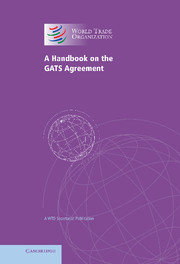Book contents
- Frontmatter
- Contents
- Preface
- Introduction
- 1 Basic purpose and concepts
- 2 Main building blocks: agreement, annexes and schedules
- 3 A closer look at domestic regulation
- 4 How the GATS is administered
- 5 The role and responsibilities of Member governments
- 6 The challenges ahead
- 7 Preparing requests and offers
- 8 Misconceptions about the GATS
- Appendix 1 Understanding your country's services trade
- Appendix 2 Relevant services statistics and classifications
- Annex: General Agreement on Trade in Services
- Index
2 - Main building blocks: agreement, annexes and schedules
Published online by Cambridge University Press: 07 October 2011
- Frontmatter
- Contents
- Preface
- Introduction
- 1 Basic purpose and concepts
- 2 Main building blocks: agreement, annexes and schedules
- 3 A closer look at domestic regulation
- 4 How the GATS is administered
- 5 The role and responsibilities of Member governments
- 6 The challenges ahead
- 7 Preparing requests and offers
- 8 Misconceptions about the GATS
- Appendix 1 Understanding your country's services trade
- Appendix 2 Relevant services statistics and classifications
- Annex: General Agreement on Trade in Services
- Index
Summary
THE BASIC STRUCTURE OF THE GATS
The GATS forms part of the Marrakesh Agreement Establishing the World Trade Organization. It establishes a rules-based framework for international trade in services, specifies the obligations of Members within that framework, and delineates a legal structure to ensure compliance. The Marrakesh Agreement includes two other multilateral agreements – GATT 1994, and the Agreement on Trade-Related Aspects of Intellectual Property Rights (TRIPS) – as well as a few plurilateral agreements. Of these, the Agreement on Government Procurement is also of relevance to trade in services.
The GATS consists of the text of the Agreement (a Preamble, 29 Articles arranged in six Parts (see Figure 2), and various Annexes) and a schedule of commitments for each WTO Member.
THE TEXT OF THE AGREEMENT
Preamble
The Preamble states the main intentions that inspired the drafting of the Agreement. These include the concept of trade expansion as a means of promoting growth and development and the objective of progressive trade liberalization through successive rounds of negotiations. Further, the Preamble explicitly confirms the right of Members to regulate, and to introduce new regulations, to meet national policy objectives. The two final considerations refer to the objective of facilitating the increasing participation of developing countries in world services trade as well as to the special economic situation of least-developed countries and their development, trade and financial needs.
- Type
- Chapter
- Information
- A Handbook on the GATS AgreementA WTO Secretariat Publication, pp. 10 - 20Publisher: Cambridge University PressPrint publication year: 2005

